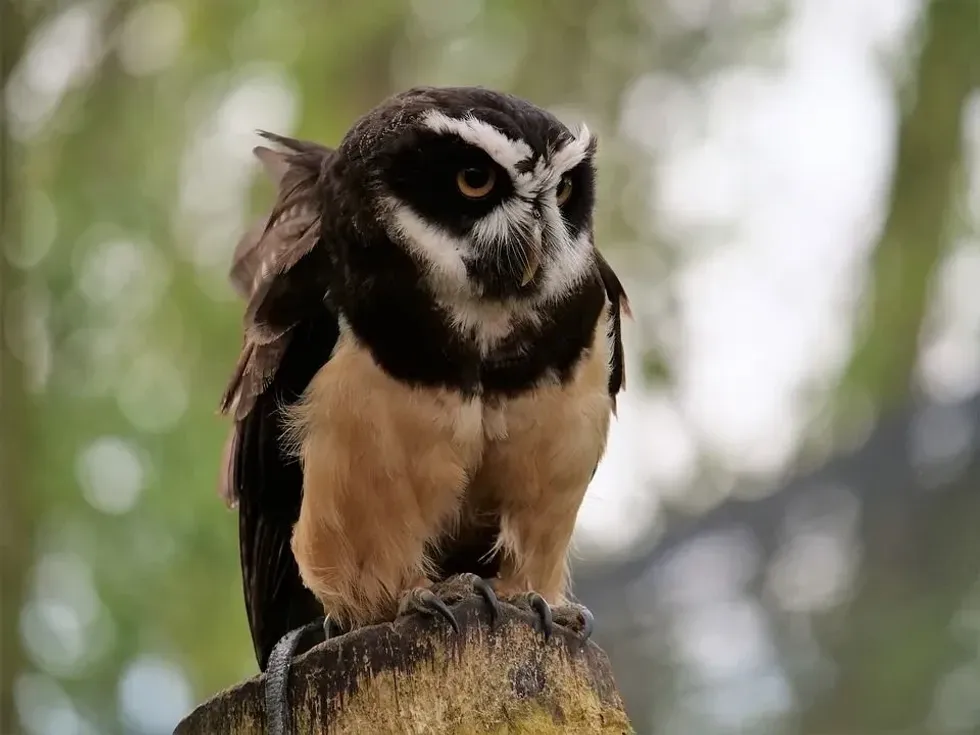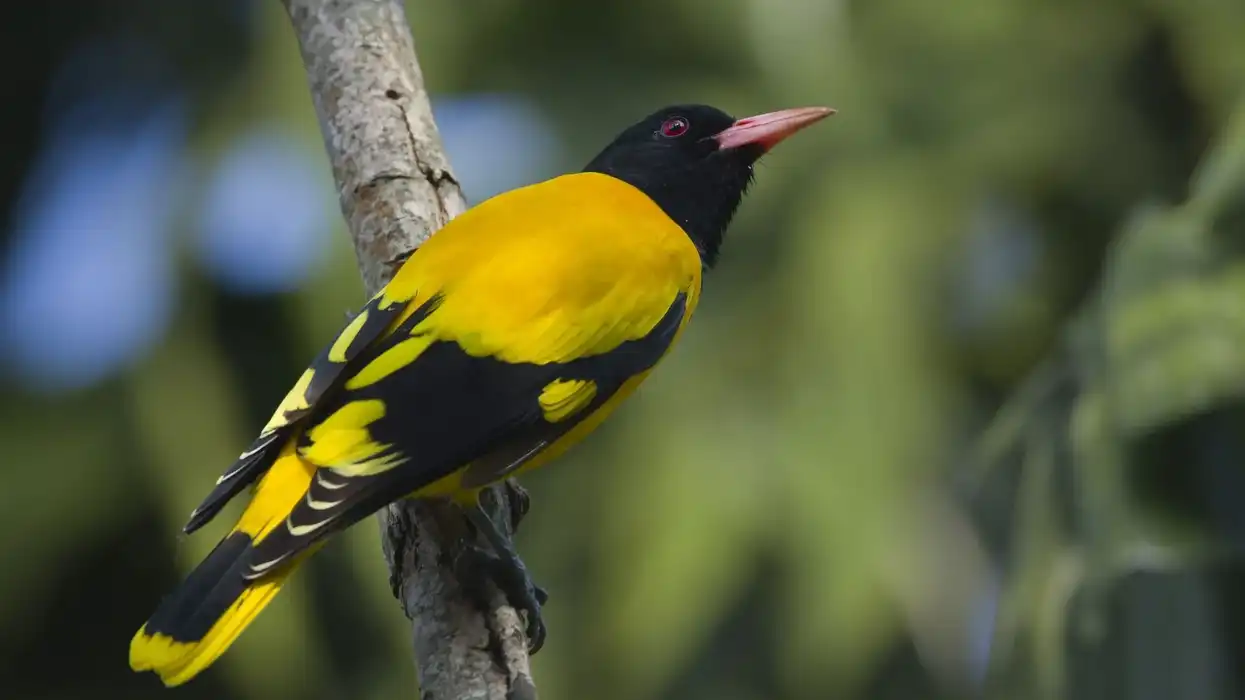The Spectacled Owl (Pulsatrix perspicillata) is known to be a large tropical owl that is native to the Neotropics. The Pulsatrix perspicillata, Spectacled Owl, is the resident breeder from southern Mexico and Trinidad in forests.
There are a total of six subspecies that differ according to size, shape, body structure, and other factors. One of the species is treated as a separate species, which is known as the short-browed owl.
The juvenile is even more distinctive than the adult who is completely white. These birds of prey are pure carnivores and feed on mice, insects, mammals, frogs, lizards, and small mammals.
The litter size of these majestic birds of Central America ranges between one to two eggs that are laid during the breeding season, which coincides with the wet season. The chicks leave the nest after around five to six weeks of hatching.
Read on for more, and after reading facts about this tropical owl, you may also look at fox sparrow facts and lark sparrow facts.
Spectacled Owl Interesting Facts
What type of animal is a Spectacled Owl?
A Spectacled Owl (Pulsatrix perspicillata) is a type of bird that is one among its other six subspecies. The Spectacled Owl is known to be largely nocturnal and is a solitary and unsocial bird that roosts singly each day.
What class of animal does a Spectacled Owl belong to?
Spectacled Owls belong to the class of birds. The bird is a resident breeder in the forests across southern Mexico and Trinidad, with its population distribution across Central America, South America, and other parts of the world.
How many Spectacled Owls are there in the world?
There is no accurate information on the population of Spectacled Owls are there in the world. The number might differ due to different factors which determine the distribution, lifespan, and life cycle of Spectacled Owls. Therefore, the total number of Spectacled Owls is not mentioned anywhere.
Where does a Spectacled Owl live?
Spectacled Owls are known to be the largest tropical owl species. These nocturnal birds are characterized by their spectacles. A large population of these owls lives near water in the tropical forests of Central and South America. They nest in a tree cavity, which is often formed when the top of a tree snaps off.
What is a Spectacled Owl's habitat?
The habitat of Spectacled Owls is near water in the tropical forests of Central and South America.
Who do Spectacled Owls live with?
Spectacles Owls are monogamous and form long-term pairs and share the parenting of their offspring known as owlets.
How long does a Spectacled Owl live?
The Spectacled Owl (Pulsatrix perspicillata) has a lifespan of up to 35 years in the wild and owls are known to live and survive for 25-30 years in captivity. Different factors affect the lifespan of Spectacled Owls.
How do they reproduce?
The females make a loud screeching call which is made to attract a male to mate with them during the breeding season. Spectacled Owls are attached to one partner and are monogamous and form pairs that are for the long term with their partners.
Their breeding starts in the dry season and also at the start of the wet season. Once the mating is complete, the eggs are laid by the females.
These birds nest in tree hollows and one or two eggs are laid, that are incubated only by the females for 30-35 days, which is standard for Spectacled Owl hatching.
After one or two eggs hatch, both parents feed the chicks and take care of them. The chicks leave the nest after around five or six weeks of hatching.
What is their conservation status?
The conservation status of Spectacled Owls is Least Concern as per the IUCN and appears that these breeding birds have no immediate threats. There are certain threats to Spectacled Owls which might cause a decline in their number.
Spectacled Owl Fun Facts
What do Spectacled Owls look like?
Spectacled Owls are characterized by 'spectacles' which are made up of white feathers present around their eyes and throat. The rest of the owl's plumage is dark brown except for the abdomen and the breast, which have a creamy shade. The Spectacled Owl size is considered to be the largest among tropical owls.
How cute are they?
Spectacled Owls are cute in their appearance and look different. However, at the same time, people can be afraid of the bird because of the way it looks at human beings. But there are no known adverse effects of Spectacled Owls on human beings.
How do they communicate?
The female Spectacled Owls communicate by making a screeching call which is loud and the male reciprocates by emitting a knocking or tapping sound which is like a thud of a hammer or a woodpecker hitting or pecking a hollow tree. The tapping sounds from the Spectacled Owl call which is responsible for their communication.
How big is a Spectacled Owl?
Spectacled Owls are medium-sized birds that are 16.1-20.6 in (40.9-52.3 cm) long and are the largest tropical American owls. It is about four times bigger than the smallest owl, the Elf Owl.
How fast can a Spectacled Owl fly?
There is no accurate information on the Spectacled Owl's flying speed. It is believed that these birds fly efficiently and perform silent flight when these nocturnal birds hunt at night with the help of their soft light feathers. During the time of reproduction, these birds of prey do not fly.
How much does a Spectacled Owl weigh?
A Spectacled Owl weighs around 1.5-2 lb (0.7-0.9 kg). The females are larger as compared to the males.
What are the male and female names of the species?
There is no specific name for the male and female Spectacled Owls. They are known as male Spectacled Owls and female Spectacled Owls respectively.
What would you call a baby Spectacled Owl?
A baby Spectacled Owl is known as a chick or owlet.
What do they eat?
Most of the diet of the Spectacled Owl consists of small mammals. Their diet also features frogs, lizards, caterpillars, crabs, snails, spiders, and also large insects. Conversely, these birds do not have many predators as they hide in the trees but can be eaten by larger birds.
Are they dangerous?
No, Spectacled Owls are not dangerous unless and until these birds of prey find something which is threatening them. But, there is no known adverse effect of a Spectacled Owl on human beings.
Would they make a good pet?
Before you start looking for a Spectacled Owl for sale, you must note that these dark-colored birds do not make good pets as this species needs a lot of space. Providing this species with their diet is also a difficult task. Some of the species of owls are illegal to own as pets in the house.
Did you know...
Spectacled Owls are known as knocking owls in Brazil, as they are one of the most dominant creatures in their native habitat.
Spectacled Owls have the best vision during the time of night among all the other animals.
Hummingbirds, kingfishers, and songbirds are known to be close relatives of Spectacled Owls.
The Spectacled Owl can turn around 270 degrees as it has 14 vertebrates in the neck.
How does a Spectacled Owl defend itself?
A Spectacled Owl is a raptor and also a bird of prey. The adult Spectacled Owls defend themselves with the help of their beak which is strong and sharp and also the talons. The ability of the owl to avoid detection is perhaps the most important weapon in its defensive arsenal.
Where does the Spectacled Owl live?
A Spectacled Owl lives near the water in the tropical forests of Central and South America.
Here at Kidadl, we have carefully created lots of interesting family-friendly animal facts for everyone to discover! Learn more about some other birds from our secretary bird facts and tawny eagle fun facts pages.
You can even occupy yourself at home by coloring in one of our free printable spectacled owl coloring pages.










